The many roles of food in public art, from aesthetic to advocacy, message to medium
If art is food for the soul and food is food for the mouth, then what is food art? Given its essential role in human life, food appears in all manner of art, from Dutch Renaissance still lifes to Andy Warhol’s Campbell soup cans. Even cooking daily meals can express a creative blend of aesthetic flavour and functional nutrition. In the realm of public art, where function and benefit for the community are often at the forefront of design, food is an especially apt subject.
This feature is part of Fieldnotes, a public art blog series by STEPS that promotes inclusive and innovative public art through interviews, storytelling, case studies, and knowledge sharing.
Artist credit: Ashley Mozo
Photo credit: Alicia Reid
The (Public) Art of Food
Indeed, taking a look at exactly what public art does reveals even more resonance with food. What distinguishes public art from other forms of art is its placement within the public realm: public art is for the general public moving through their day-to-day lives. Public art can be made for an individual, but it should also appeal to the collective that passes through its space—just as cafeteria spaghetti can be made to a chef’s taste, but all the students have to eat it too. To that end, public art is often expressive not only of the individual artist but also of the shared value and the character of a community.
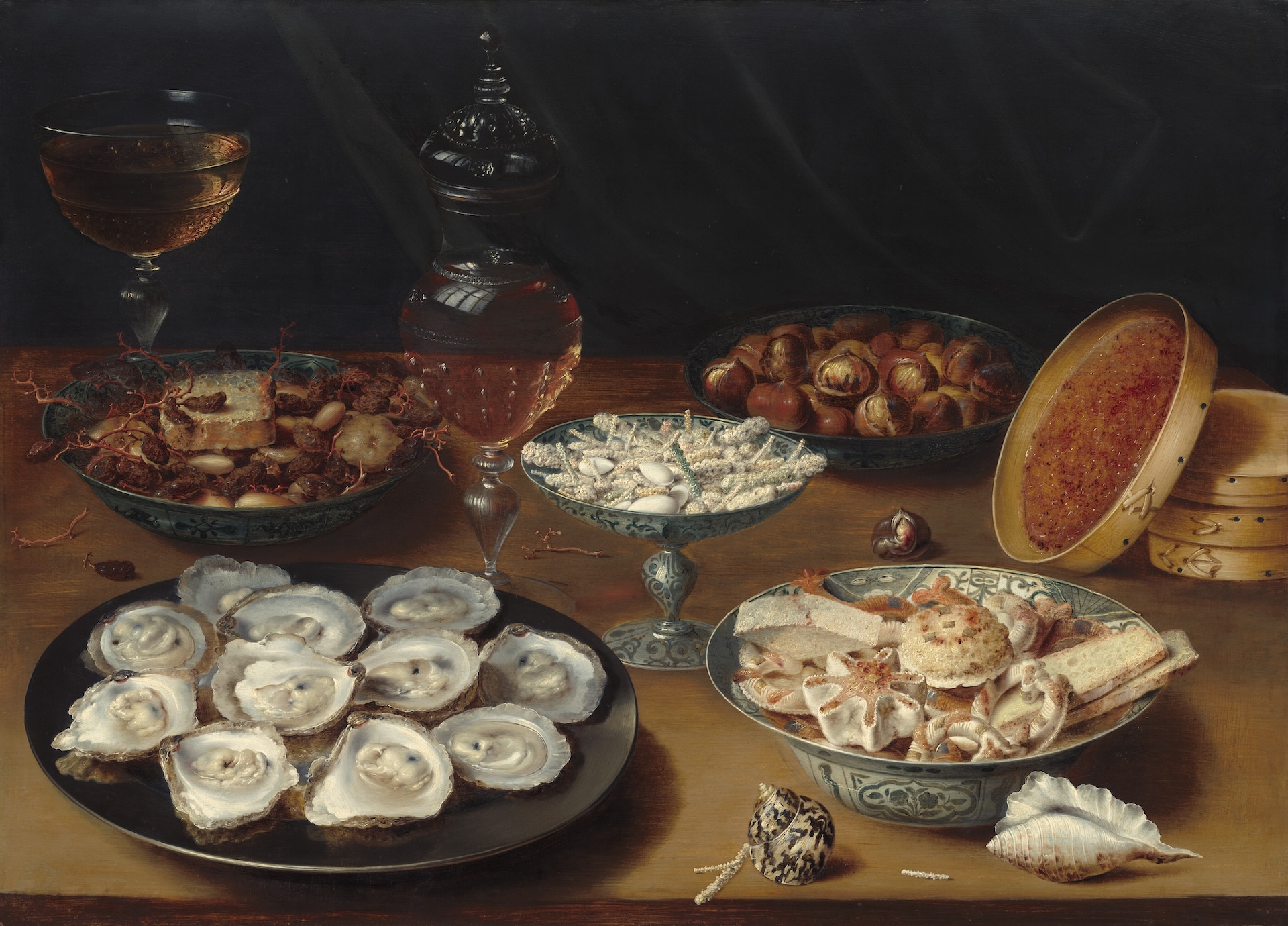
Expensive foods demonstrate abundance in Dishes with Oysters, Fruit, and Wine still life by Osias Beert the Elder
Photo credit: National Gallery of Art, Washington
In a similar sense, a place’s culinary identity involves not only the tastes of individual cooks and diners but also the shared food experiences of the community. Sliding into the restaurant booth, sitting around the dining room table—so many of our food experiences are communal. Who does your food come from? Who do you eat with? Who do you cook for? From the celebration at a wedding reception to the colonial narratives surrounding Thanksgiving dinners, food implicates us in the collective rituals of meaning-making via the meal.
Even when we’re alone, our interactions with food, mediated by culinary traditions and conventions, result in a sensory experience shared with others. When you bite into an apple, your experience of sweet-and-tangy echoes all the bites of apple that have come before you. Wandering down a city street, you spy an apple as a pop of yellow-red paint on a sidewalk and think, “Oh, how sweet!”
By exploring food stories, public art can tap into a potent shared vocabulary of experience, inviting reflections on how food intervenes in our daily routines and connections. Issues of food distribution, food injustice, and food insecurity pervade our communities, and both the presence and absence of food are integral to how we move through space. How many moments of our lives are spent collecting ingredients or finding places to eat? In the Lascaux Cave, paleolithic humans painted big game in anticipation of the hunt. Something of the hunter-gatherer remains in us: we look towards the next meal.
Taste the Difference: Celebrating Culinary Diversity in Public Art
Art about food is not just art about food; explorations of culinary knowledge and aesthetics have the potential to be powerful celebrations of diversity and intercultural exchange. Oftentimes, trying out a new cuisine is our first encounter with an unfamiliar culture, and learning to value culinary diversity is one aspect of accepting cultural differences. The food culture of a neighbourhood is the material evidence of its cultural identity, telling us about the different communities that make their homes and their meals there.
From cooking shows to trending recipes, the recent years have seen increased cultural diversity in the food represented on screen and in art, but that kind of representation has its downsides. This culinary diversity “can often be a double-edged sword when foods from marginalized communities can easily be commodified,” explains artist and frequent food illustrator Meegan Lim. While it’s easy to confuse trying unfamiliar cuisines with deep cultural appreciation, the simple consumption of diverse food, particularly those marketed as “ethnic” or “exotic,” is not the same as respect for other cultures.
One artistic way to resist the commodification and exotification imposed on so-called “ethnic” foods is to enrich food imagery with cultural knowledge. In Beyond the Plate, a series of storefront public art activations by Meegan Lim for her hometown of Brampton, vibrant illustrations of locally significant cuisines are accompanied by textual explanations of historical and cultural backgrounds.

A vacant storefront animated by an illustration of Kamayan, the traditional Filipino practice of eating by hand
Artist credit: Meegan Lim
Photo credit: May Shi
As part of the Main Street Window Activation Pilot Project by the City of Brampton and STEPS Public Art, these six pieces animated empty storefronts and drew inspiration from Downtown Brampton’s food culture, educating passersby on topics ranging from Bengali desserts to Indigenous foodways. According to Meegan, her experience of leading several walking tours and learning about community members’ relationships to food proved her hypothesis: “food is ultimately a tool for human connection.”
Indeed, food and associated memories can bring people together from all walks of life. “Food signifies companionship, intimacy and nostalgia, not only with family and friends, but with strangers as well,” says Ashley Mozo, the artist behind Food City, a public artwork illustrating the culinary landscape of Cooksville, one of Missisauga’s Cultural Districts. To create public art that represents the experiences of the community, STEPS collected over one hundred local food story submissions through community engagement events, providing the inspiration for the piece.
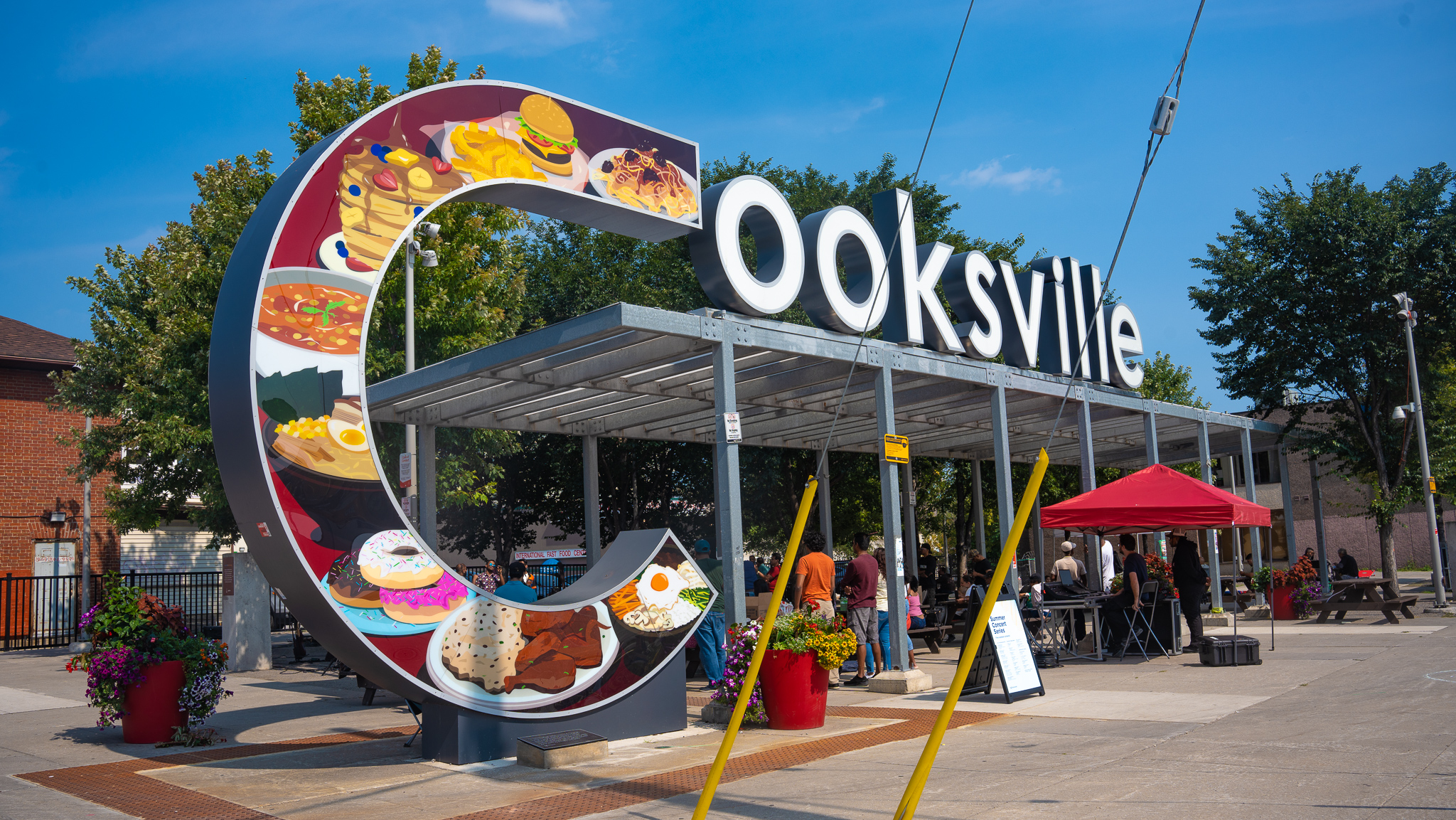
The iconic Cooksville sign tells the food stories of the local community
Artist credit: Ashley Mozo
Photo credit: Alicia Reid
Food City is an illustration of Cooksville’s culinary landscape as a dinner table with the food taking the place of the buildings. The piece went on display on posters at local businesses, light pole banners, a bus shelter, and the Cooksville sign. “I wanted to portray a potluck that invites everyone to share meals and stories together,” Ashley explains her piece, a colourful dinner spread of an array of dishes from burgers to bibimbap.
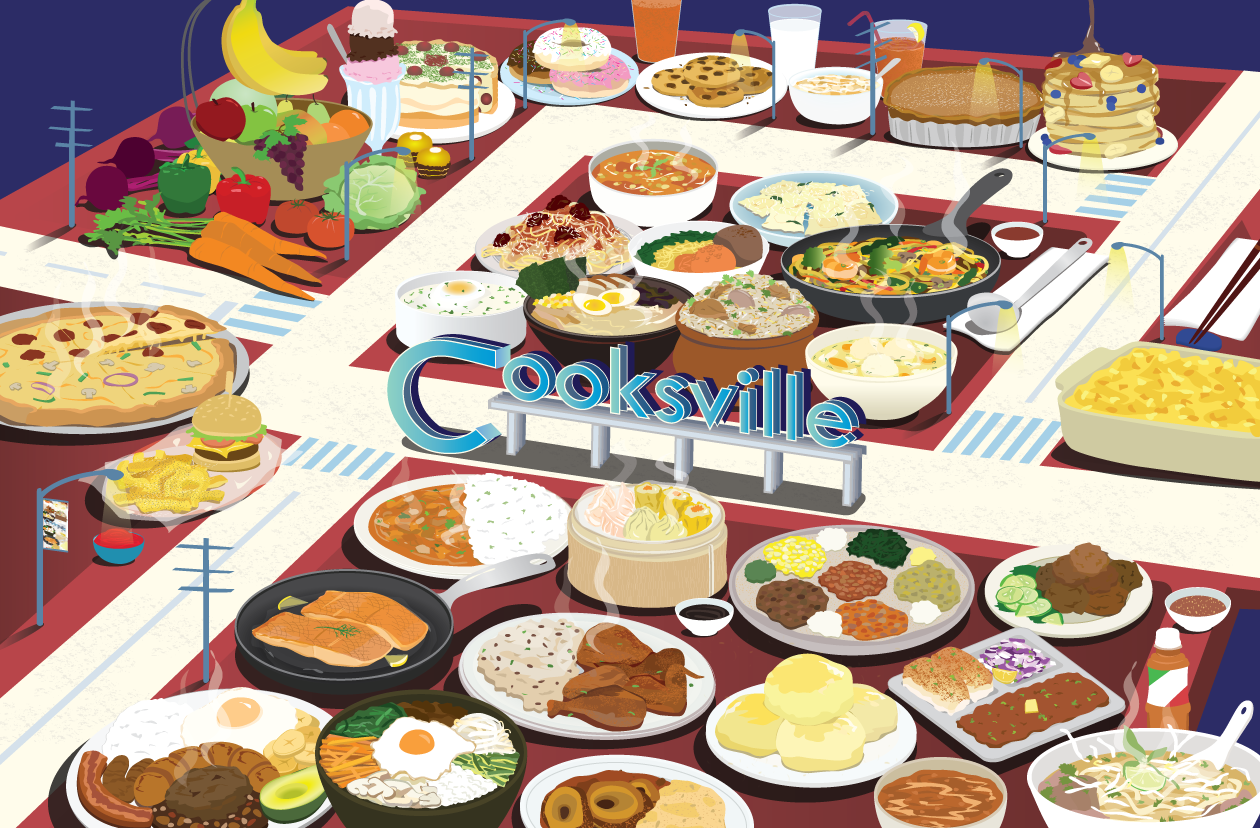
The Cooksville neighbourhood reimagined into a streetview of diverse cuisines
Artist credit: Ashley Mozo
While food in itself cannot bridge the gaps between cultures, the appreciation and celebration of culinary differences in public art can uplift marginalized cultures for a more inclusive community identity. Beyond the Plate and Food City demonstrate the value of intercultural exchange, of sharing a memory and a meal.
Food Security, Food Sovereignty: Public Art as Advocacy
In its role as a locus of community connection, food is also a contested battleground of exploitation and inaccessibility. Structural inequality plays a central role in our daily meals, determining both what food we eat and how much. According to Beyond the Plate artist Meegan Lim, whose other work includes explorations of the relationship between food and colonization, food systems are fraught with injustice, from price gouging to food insecurity.
“Food is essential,” Meegan says, “and systems of power have found ways of weaponizing it.” To serve the community, public art has a responsibility not only to highlight the diversity of food culture but also to shine a spotlight on the injustices present in our food systems.
According to Statistics Canada, 18% of Canadian families reported experiences of food insecurity in 2022. In the summer of that year, artist Kanisha Dabreo, working with STEPS, animated a North York Shipping Container Pop-up Food Bank at the Jane and Sheppard Library with a vibrant mural, bringing awareness to this crucial community support for those struggling with food insecurity. Apart from highlighting the key work done by the North York Harvest Food Bank, this locally-inspired Afrocentric mural is also a celebration of the diverse members of Toronto’s Jane and Finch community.
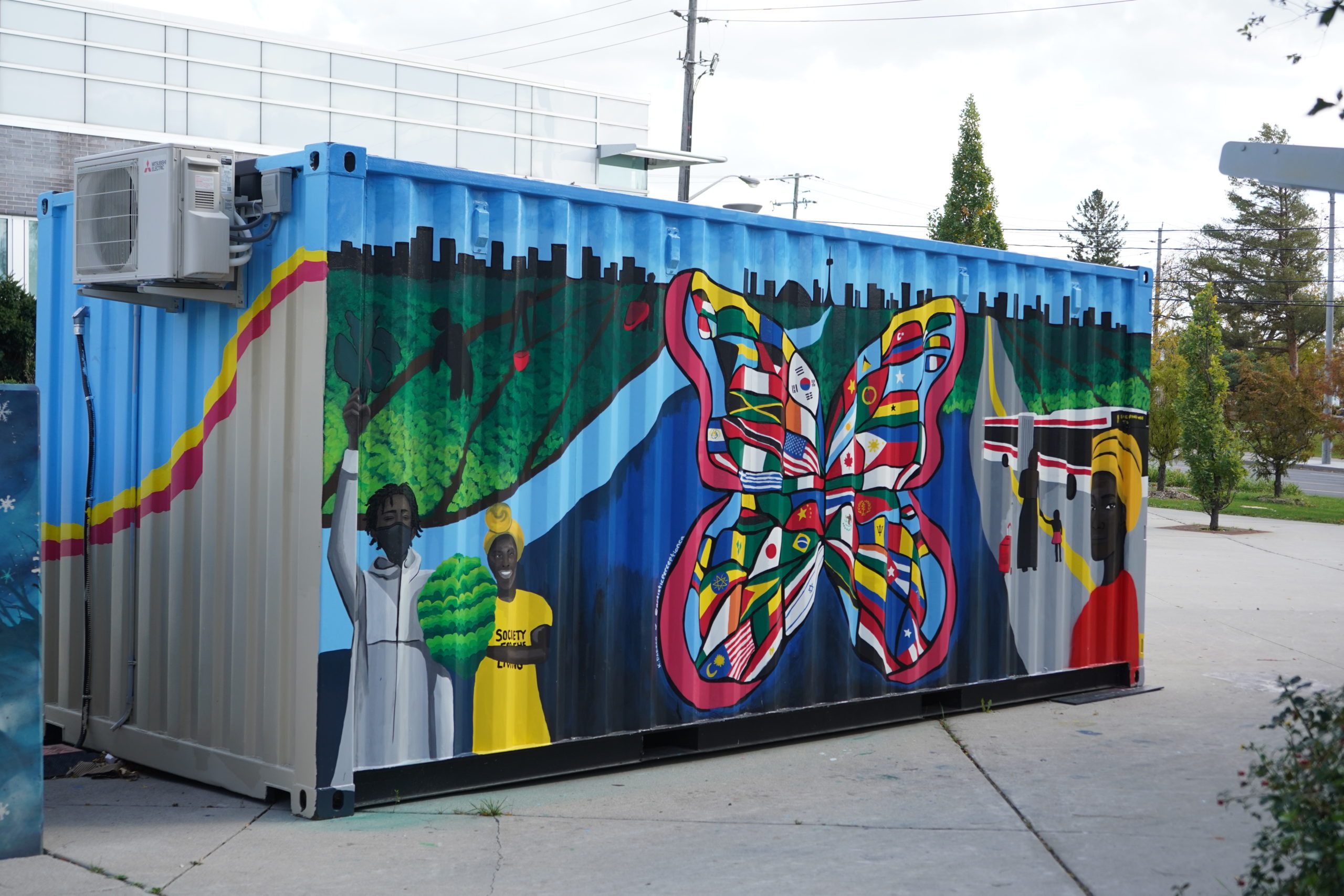
A pop-up shipping container food bank with a mural of a view of North York, celebrating diversity with a painted butterfly composed of the flags of many nations
Artist credit: Kanisha Dabreo
Photo credit: Kyle Jarencio
While food banks are a lifeline for many people living in poverty, their necessity reveals deeper issues baked into our food systems, which are motivated by profit rather than the human right to food. For some food activists, the arts offer a way to explore alternatives to our current food system, wherein large corporations control agricultural production from the farm to the table.
In 2022, La Via Campesina, an international farmers organization, published a virtual gallery of 22 artists exploring the concept of “food sovereignty” as an alternative to corporate-dominated food systems. In 1996, La Via Campesina first coined the term “food sovereignty,” described as “the right of peoples to healthy and culturally appropriate food produced through ecologically sound and sustainable methods, and their right to define their own food and agriculture systems.” Through the virtual gallery, La Via Campesina uses art to share an alternative vision of food, which emphasizes the rights of agricultural labourers and importance of Indigenous cultures for creating just agricultural systems.
Explorations of food justice through art should address the international systems that control the distribution and access of food, but regionally-based food advocacy also sheds light on the systemic inequalities in food access. One urgent regional food injustice is the food insecurity experienced in Nunavut and other northern territories, where the price of groceries is exorbitantly high.
In Feeding My Family, a sculpture exhibited at Montreal’s 2019 Nuit Blanche, Nunavut-based Inuk artist Jesse Tungilik depicted a hunter and a seal covered in grocery receipts to highlight the punishingly high cost of living in the North. Further south, Toronto Food Stories is an artist residency hosted by FoodShare, a Toronto charity that advocates for the right to food and fights against food injustice. The residency connects artists with food growers and organizers, using art to explore solutions for local food injustice and food insecurity.
With food price inflation and the COVID-19 pandemic’s impact on the economy, the urgent need for justice in our food systems is increasingly relevant. If public art should explore values and themes shared by the community that it serves, then what is more universal than our need—and struggles—to eat?
Something to Chew On: Cooking as Artistic Medium?
From cooking to baking, Food City artist Ashley Mozo explains, “Food is an art form in and of itself,” and one that explores endless variations of colours, textures, and flavours. In recent years, the aesthetics of cooking have become a larger part of media coverage of food. Social media and television, such as Netflix’s documentary series Chef’s Table, showcase the craft behind every dish. However, this aesthetic appreciation for cooking is often limited to the inaccessible world of expensive, Michelin star restaurants. The fine art of cuisine is available to the public—as long as they can pay.
A 2021 article by food scholars Andrea Borghini and Andrea Baldini explores the potential of cooking and dining as truly public forms of art that serves the community rather than a select elite. Borghini and Baldini identified some strategies for supporting a public art of cooking, including providing subsidies to certain food vendors or home cooks, so their food may reach communities that cannot typically afford it. The article also considers cooking knowledge as an art form, suggesting the sponsorship of recipe creation. Food doesn’t always have to be an image or a symbol that leads to another theme; instead, it can be the star of its own show.
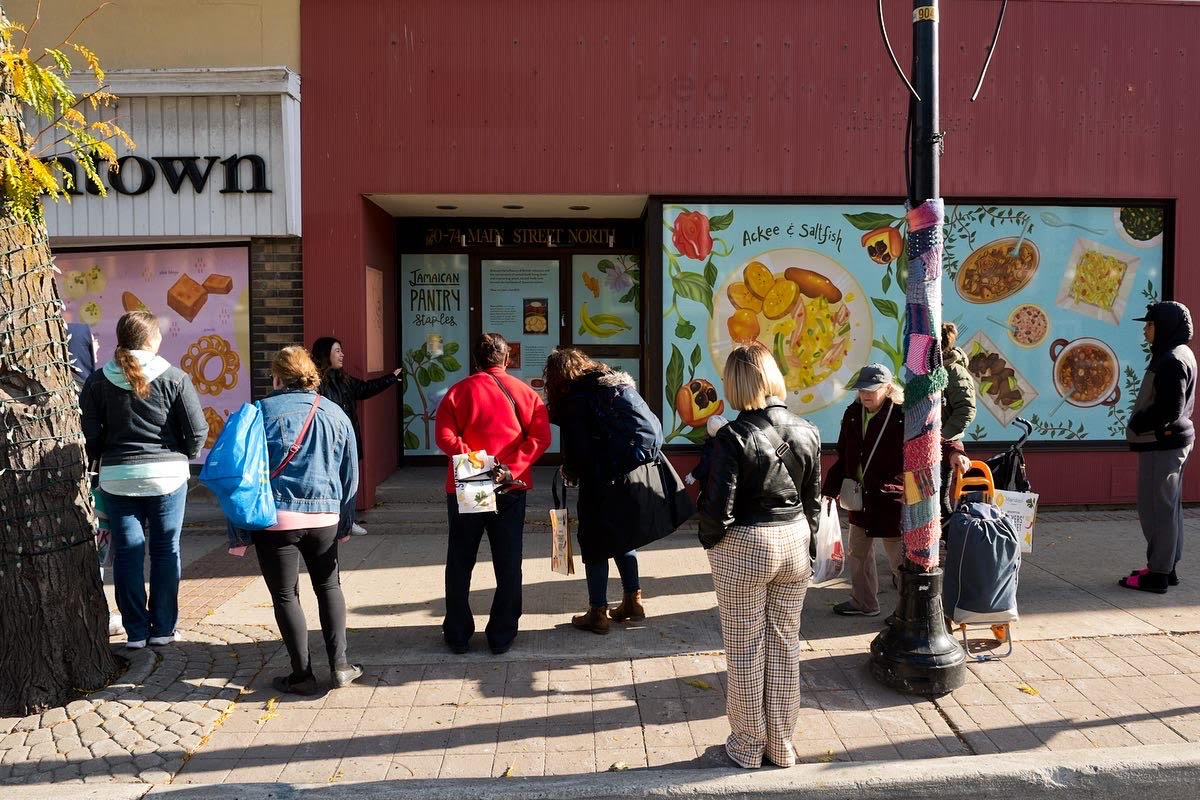
Stopping at the display of Jamaican Pantry Staples, Meegan Lim leads a walking tour of the Brampton Beyond the Plate storefront activations
Artist credit: Meegan Lim
Photo credit: Herman Custodio
For Beyond the Plate artist Meegan Lim, who frequently explores food in her artistic practice, food is much more than just sustenance: “It’s culture and history, it’s a part of family and memory, it exists alongside pain and trauma, and it can be an art form that can encapsulate all of the above.” Whether or not cooking and dining will become popular mediums of public art is as yet unknown. One thing’s for sure, though: mixing food and art is a recipe for success.
About the Writer
Wenying Wu (she/her) is a student of English and Chinese literature beginning her MA in Comparative Literature at the University of Toronto in September of 2024. Her research interests include science fiction, body horror, and the representation of dreams. Wenying was the Cultural Content Writer at STEPS during the 2024 summer season.
Have a story to pitch or an exciting idea on how we can work together on a Fieldnotes feature? Contact us to get the conversation started.


